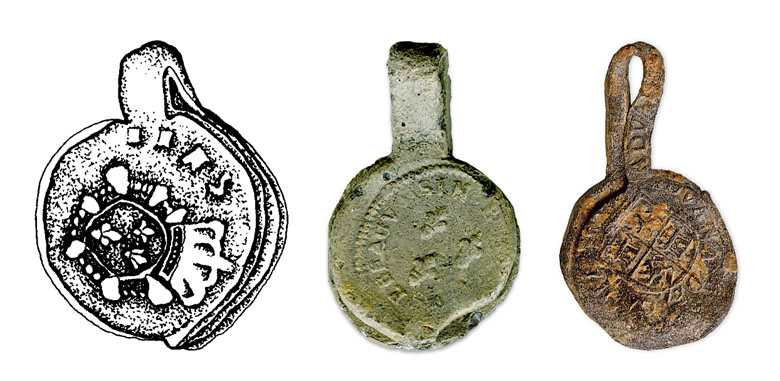
Thirteen whole and fragmentary lead cloth seals have been found at Los Adaes. Shown here are two French seals and one Spanish (on right).
The sealing of bolts of cloth with a lead seal as a stamp of quality was a long tradition in Europe that began in the Middle Ages. Seals are associated with exported cloth and served several purposes over the centuriesãquality assurance, place of manufacture, and merchant ownership.
The cloth seals from Los Adaes consist of a lead ring and lead rivet attached by a narrow width of lead. The lead rivet passed through the end of a bolt of cloth, and the seal was bent so that the lead ring would fold onto the lead rivet. The seal was then stamped with pliers. Lead seals are not as numerous on Spanish colonial sites as they are on French or British colonial sites in North America. Of the 13 seals recovered at Los Adaes, five are French, one Spanish, one British, and six for which the country of origin could not be identified.
The Spanish lead seal found at Los Adaes is the only Spanish cloth seal reported for Spanish colonial sites in Texas. This is a customs seal for the Spanish port of Cˆdiz, indicated by the phrase, –ADUANA REAL DE CADIZ,” or, –royal customs at Cˆdiz.” It is possible that the cloth from this seal may not have been Spanish, but may have had to pass through customs in Cˆdiz before being shipped to the Americas. France and England had large export cloth industries during the 18th century, but Spain did not. The general lack of Spanish cloth seals on archeological sites in the Americas suggests that the Spanish colonies may have been consumers of British and French cloth. Spain was importing a great deal of French cloth during the late 17th century. Hundreds of Indians were being clothed with British cloth in northeast Texas during the 1716 Ram„n expedition, and soldiers from Los Adaes confiscated sixty bolts of cloth from a French trader in 1757. The French traveler Pˆges paid for food with cloth at Los Adaes in 1768.
The identifiable lead seals at Los Adaes are mostly French, suggesting that much of the cloth consumed at Los Adaes was French. Since much of the cloth exported to the Americas on Spanish ships was not Spanish in the early to mid 18th century, and there was clearly a source for French cloth in Louisiana, the French and British cloth seals at Los Adaes may well represent either legally or illegally acquired cloth.